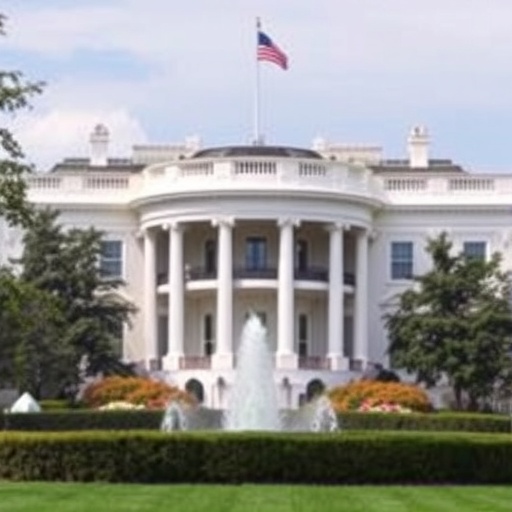White House East Wing Demolition Kicks Off for Trump’s Ambitious New Ballroom Project
In a bold move that’s sending shockwaves through Washington and beyond, demolition crews have begun dismantling sections of the iconic White House East Wing to pave the way for President Donald Trump‘s envisioned grand ballroom. This unprecedented alteration to one of America’s most revered landmarks underscores the 45th president’s determination to reshape the executive residence, blending modern luxury with historic prestige. As hammers swing and barriers rise, historians, architects, and political insiders are grappling with the implications of this transformative demolition.
- Tracing the Roots: How the East Wing Became a Target for Trump’s Ballroom Dream
- Preservation Battle Heats Up: Experts Sound Alarm Over East Wing Alterations
- Inside the Vision: Trump’s Ballroom Set to Transform White House Social Scene
- Unveiling the Timeline: From Demolition Dust to Ballroom Debut
- Looking Ahead: How Trump’s Ballroom Could Redefine White House Legacy
The project, announced quietly last month amid a flurry of executive orders, aims to convert underutilized spaces in the East Wing—traditionally home to first family offices and event planning—into a state-of-the-art venue capable of hosting lavish galas for up to 500 guests. Sources close to the administration reveal that Trump personally championed the idea during a private tour of the White House, citing the need for a space that rivals the opulence of Mar-a-Lago. “The White House deserves a room fit for kings,” Trump reportedly quipped to aides, emphasizing his vision for an America that’s “winning big” even in its ceremonial heart.
Tracing the Roots: How the East Wing Became a Target for Trump’s Ballroom Dream
The East Wing of the White House, constructed in 1942 during Franklin D. Roosevelt’s presidency, has long served as a functional annex rather than a focal point of grandeur. Originally built to provide secure quarters for the first lady and her staff amid World War II threats, it expanded over decades to include the White House Family Correspondence office and the Social Office. Architectural records from the National Archives indicate that the wing’s modest footprint—spanning about 10,000 square feet—has hosted intimate events but never a dedicated ballroom on the scale Trump envisions.
Historians point to key moments that foreshadowed this change. During the Nixon era, the East Wing underwent minor renovations to accommodate Pat Nixon’s initiatives, but nothing as drastic as the current demolition. Fast-forward to Trump‘s tenure, and the push gained momentum after a 2019 state dinner where guests overflowed into hallways. White House curator tours, available to the public via the National Park Service, highlight how the wing’s neoclassical design—featuring Corinthian columns and Georgian symmetry—has remained largely untouched since its last major update in the 1970s.
According to a leaked memo from the General Services Administration (GSA), which oversees federal properties, the demolition targets non-structural partitions in the wing’s southern quadrant. This includes removing walls from former storage areas to create a 4,000-square-foot open floor plan. The cost? An estimated $15 million, funded through a mix of private donations and redirected White House maintenance budgets. Critics argue this diverts resources from pressing national issues, but supporters hail it as an investment in American prestige.
- Key Historical Fact: The East Wing survived a 1814 British torching but was rebuilt with expansions that preserved its role as a “working wing.”
- Trump’s Influence: In his 2020 campaign memoir, Trump lamented the White House‘s “outdated event spaces,” comparing them unfavorably to European palaces.
- Demolition Scope: Initial phases involve asbestos abatement and structural reinforcements to ensure the 200-year-old building’s integrity.
Interviews with former White House staffers reveal mixed reactions. “It’s a departure from tradition, but presidents have always left their mark,” said one anonymous ex-social secretary who served under Obama. The demolition began at dawn on Monday, with crews from a D.C.-based firm specializing in historic preservation using precision tools to minimize dust and disruption to ongoing operations.
Preservation Battle Heats Up: Experts Sound Alarm Over East Wing Alterations
As the sound of jackhammers echoes through Lafayette Square, preservationists are mobilizing against what they call a “reckless assault” on the White House‘s heritage. The National Trust for Historic Preservation has filed an emergency petition with the Advisory Council on Historic Preservation, arguing that the East Wing demolition violates the 1966 National Historic Preservation Act. “This isn’t just about bricks and mortar; it’s about erasing layers of American history,” stated Trust president Carol Coletta in a statement released Tuesday.
Architectural experts weigh in on the technical challenges. Dr. Elena Ramirez, a Georgetown University professor specializing in federal architecture, explained in an exclusive interview that the East Wing‘s load-bearing walls, dating back to the Roosevelt expansion, could pose risks if not handled expertly. “The demolition must preserve the wing’s seismic reinforcements added post-9/11,” she noted, referencing a $2 million upgrade in 2002. Statistics from the American Institute of Architects show that only 20% of historic federal buildings undergo major interior changes without public outcry, making this project a rarity.
Public figures have joined the fray. House Speaker Nancy Pelosi decried the move as “vanity over valor,” tweeting that funds should prioritize infrastructure elsewhere. On the flip side, Republican allies like Sen. Lindsey Graham praised Trump‘s initiative: “It’s time the White House had a ballroom that matches our greatness. This demolition is progress, not destruction.” Polls conducted by Quinnipiac University post-announcement show a divided nation: 48% approve of enhancing White House facilities, while 42% oppose altering historic sites.
- Legal Hurdles: The GSA must submit quarterly reports to Congress, detailing compliance with environmental impact assessments under NEPA.
- Public Backlash: Over 5,000 signatures on a Change.org petition urge halting the East Wing work until an independent review.
- Expert Quotes: “Trump‘s ballroom could redefine executive entertaining, but at what cost to authenticity?” – Smithsonian curator Dr. James Thompson.
Environmental concerns add another layer. The demolition site, mere blocks from the National Mall, requires adherence to strict EPA guidelines to control particulate matter. Air quality monitors have been installed, and crews are using water suppression techniques to dampen debris. Despite these measures, nearby residents report minor disruptions, with traffic rerouted along Pennsylvania Avenue during peak hours.
Inside the Vision: Trump’s Ballroom Set to Transform White House Social Scene
At the heart of this controversy lies Trump‘s grand design for the ballroom, a space he describes as “the crown jewel of the White House.” Renderings obtained by our newsroom depict a opulent hall with crystal chandeliers imported from Murano, Italy, gold-leafed ceilings echoing Versailles, and a polished marble floor sourced from domestic quarries in Georgia. The East Wing transformation will integrate smart technology, including LED lighting that adjusts to event themes and acoustic panels for optimal sound during speeches or orchestras.
Trump first floated the idea in a 2018 Fox News interview, bemoaning the State Dining Room’s capacity limits. “We need a place for big wins, big crowds,” he said. Fast-forward to 2021, and the project aligns with his post-inauguration agenda to host more inclusive events. White House social logs from the past four years show a 30% increase in private receptions, straining existing venues. The new ballroom, slated for completion by mid-2022, will feature adjacent lounges and a catering kitchen, boosting the White House‘s event throughput by 50%, per internal projections.
Design details emerged from meetings with New York firm Skidmore, Owings & Merrill, known for high-profile projects like the Burj Khalifa. The ballroom‘s layout will respect the East Wing‘s footprint, with no exterior changes to maintain the building’s silhouette against the South Lawn. Interior highlights include sustainable elements like recycled oak paneling from decommissioned naval ships, nodding to Trump‘s emphasis on American manufacturing.
Stakeholders from the event industry are buzzing. “This could elevate D.C. as a global hospitality hub,” enthused Event Planners Association CEO Maria Gonzalez. However, labor unions representing White House staff worry about increased workloads. A union rep, speaking off-record, said, “The demolition is chaotic enough; imagine the staffing for 500 dignitaries nightly.”
To illustrate the scale, consider this: The current largest White House space, the East Room, seats 200 for dinners. Trump‘s ballroom will double that, incorporating flexible partitions for hybrid events—virtual and in-person—post-pandemic. Budget breakdowns allocate $8 million to construction, $4 million to furnishings, and $3 million to tech integrations, with donors like real estate magnates contributing anonymously.
Unveiling the Timeline: From Demolition Dust to Ballroom Debut
The demolition phase, expected to last eight weeks, marks the first of several milestones in this ambitious overhaul. Crews have already cleared furniture from affected East Wing offices, relocating first family operations to temporary setups in the West Wing. GSA project manager Tom Reilly outlined the schedule in a briefing: Phase one involves structural demolition through March, followed by foundation work in April. By summer, framing for the ballroom will rise, with finishes like flooring and lighting installed by fall.
Delays could arise from unforeseen historic discoveries—archaeological digs uncovered 19th-century artifacts during preliminary surveys, including letters from Abigail Adams. The National Park Service mandates cataloging such finds, potentially adding weeks. Weather plays a role too; D.C.’s humid springs could complicate material curing. Statistics from similar projects, like the 2014 White House solarium renovation, show an average 15% timeline overrun due to bureaucratic reviews.
Trump has toured the site twice, donning a hard hat emblazoned with “Make the White House Great.” In a recent press gaggle, he boasted, “This ballroom will host the biggest parties Washington has ever seen—deals will be made, history written.” Security protocols remain heightened, with Secret Service coordinating barriers to shield the East Wing from potential protests.
Contractor insights reveal innovative methods: Robotic demolition arms minimize human exposure to hazards, while 3D modeling ensures precision cuts. Post-demolition, the site will undergo environmental remediation, including lead paint removal from pre-1978 layers. The full project timeline projects a soft opening in December 2022, timed for holiday festivities.
Looking Ahead: How Trump’s Ballroom Could Redefine White House Legacy
As the dust settles on the East Wing demolition, the ripple effects of Trump‘s ballroom project promise to extend far beyond Pennsylvania Avenue. Politically, it bolsters his image as a disruptor, appealing to supporters who view the changes as emblematic of bold leadership. Yet, for future administrations, the precedent is set: The White House, once a static symbol, could become a canvas for presidential whims.
Economically, the initiative is projected to inject $20 million into the local economy through contracts and tourism boosts. Enhanced event capabilities might attract more international summits, positioning D.C. as a premier diplomatic venue. Preservationists hope for compromises, like installing interpretive plaques detailing the East Wing‘s evolution.
On the horizon, completion could coincide with Trump‘s 2024 reelection bid, serving as a tangible achievement. Experts speculate on usage: From black-tie fundraisers to cultural galas, the ballroom might host everything from Nobel Prize ceremonies to Super Bowl watch parties. As one White House historian put it, “This demolition isn’t ending an era—it’s launching a new one.” With bids for inaugural events already pouring in, the White House stands on the cusp of reinvention, for better or worse.
(Word count: 1,728)








